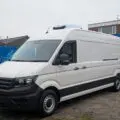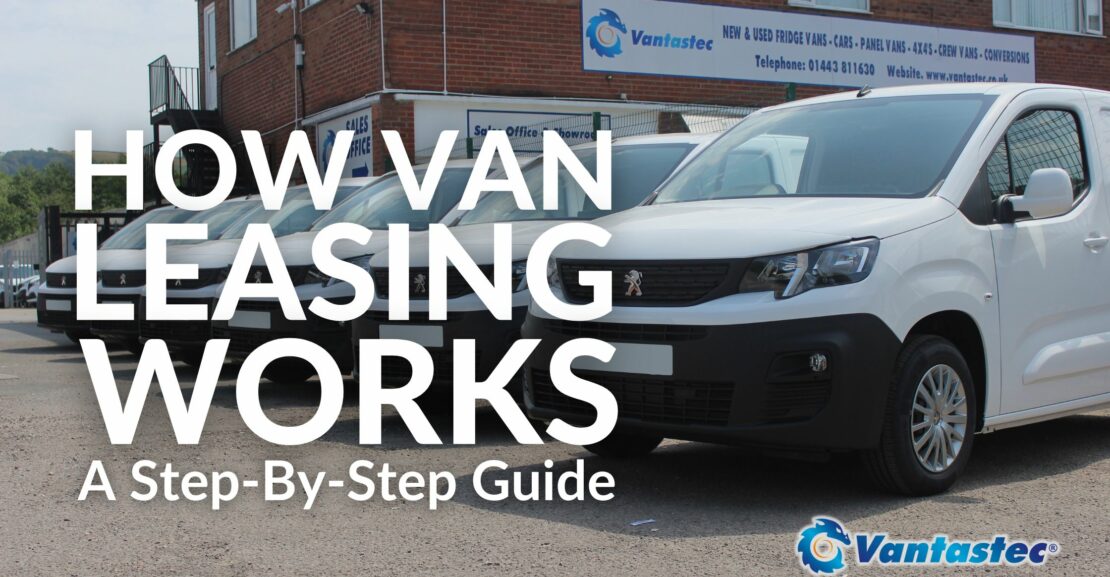Van Leasing Explained: How Van Leasing Works With Vantastec
In this step-by-step guide, we’ll be explaining exactly how van leasing works at Vantastec and whether it’s a viable finance option for you and your business.
So, you’ve decided to purchase a new van for your business on finance.
You’ve browsed all of your potential options and decided a finance lease is the one for you – but you have no idea exactly how van leasing works.
The term ‘leasing’ gets used a lot. Let’s get one thing straight: leasing is not the same as renting.
A finance lease is a type of finance arrangement where you own 97.5% of the vehicle.
With a rental agreement, you never own any percentage of the vehicle whatsoever.
The only finance agreement where you own the vehicle outright is a hire purchase – but that’s not why you’re here. You want to know more about leasing.
Leasing can be a fantastic way for you to experience all the perks of a brand-new van without the eye-watering upfront costs.
There’s a reason why so many business owners choose to lease their vehicles these days.
So, without further ado, here is our complete guide on how van leasing works at Vantastec:
Looking To Lease Your New Fridge Or Crew Van? Click Here To Browse Our Full Stocklist
What Is A Finance Lease?
All Vantastec leasing deals are what’s called a ‘finance lease.’
A finance lease is a type of finance agreement that spreads the cost of a vehicle into affordable monthly payments with a minimal upfront cost.
If you’re familiar with a personal contract purchase (PCP) in the car world, a finance lease functions in a similar way.
Here’s how finance lease deals are typically structured:
Deposit > Monthly Payments > Balloon Payment
There are no additional mileage charges with a finance lease. The mileage guidelines are there simply so we can calculate a rough estimate of the vehicle’s worth at the end of the agreement, and calculate the balloon accordingly.
For example: if you’ve signed up to a five-year plan with 10,000 miles per annum, this means your vehicle should have done 50,000 miles by the end of the agreement.
Whereas if you’re doing 20,000 miles per year, in five years time you would have done 100,000 miles.
A vehicle that’s done 50,000 miles will be worth more than a vehicle that’s done 100,000 miles. Therefore, the finance companies can put a higher balloon at the end to reduce your monthly payments.
If you’re worried about mileage restrictions, you can always choose a finance lease with no balloon. This eliminates the risk of exceeding the mileage guidance and reducing the vehicle’s value at the end – but it will mean your monthly payments will be higher.
Finance Lease vs Hire Purchase
At Vantastec, we offer two types of finance plans: finance leases and hire purchases.
Though both are straightforward ways to spread the cost of your vehicle, they are fundamentally different.
The main difference is with hire purchase, once all your monthly repayments and the option to purchase fee is paid, you own the van outright at the end.
With a finance lease, you will receive 97.5% of the resale value, while the finance company owns the remaining 2.5%
Secondly, hire purchase agreements do not typically come with a balloon payment at the end and often require a deposit of the vehicle’s full VAT plus 10% upfront.
This, of course, means you won’t pay any VAT on top of your monthly payments. However, it does mean monthly payments are typically expensive than, say, a finance lease.
If you’re curious to learn more about the differences between leasing and HP, check out our full finance lease vs hire purchase guide.
How Van Leasing Works: Step-By-Step
Now that we’ve established the ins and outs of a finance lease. Let’s break down step-by-step how van leasing works at Vantastec:
Step #1: Choose Your Van
Step one is the fun part: choosing your van.
There are a number of key factors you need to consider when picking the perfect van for you; Size, style, price and fuel efficiency just to name a few.
Buying a new van can be daunting. But doing plenty of research into the available options is always a must.
Need help on what to look for when buying a new van? Check out our 2025 van buying guide for more.
Step #2: Customise Your Finance Plan
Finance agreements can be tailored to suit your financial situation.
Three key elements can be changed to get your monthly payments to a figure that looks right for you. They are:
- The deposit
- The length of the agreement
- The balloon payment at the end
The more money you put down as a deposit, the lower your monthly payments.
The higher the balloon payment at the end, again, the lower your monthly payments.
Then, you’ll have the option to spread your payments across 36, 48 or 60 months. The longer the term – again – the lower your monthly payments.
Vantastec finance lease deals typically come with a £1500 +VAT deposit upfront (but zero deposit deals are available) and are spread across 60 months to give you the most affordable plan.
We also like to keep balloon payments low. That way, if your trade-in your van at the end of the agreement, the vehicle is worth more than the balloon payment and you’re in positive equity.
If the balloon payment is higher, you could owe more than what the vehicle is worth.
At Vantastec, we try to be as upfront with our finance plans as possible. That way, you get to avoid any nasty surprises at the end of the agreement.
Step #3: Apply For Finance
Next, all you need to do is submit a business finance application.
Finance companies will ask for some information about and your business such as the type of finance you’re after, information about you and the business etc.
Once you’ve submitted your application, we will be notified as to whether your application has been accepted or declined and will contact you to discuss the next steps.
If unfortunately, you’ve been declined by our primary lender, we’ll discuss some alternative options.
But if your application is successful, we can proceed to the next step…
Step #4: Pay Your Deposit
If you’re signed up to a zero deposit lease, you can skip this step entirely.
After you’ve been accepted on finance, you’ll then need to pay your deposit to get the ball rolling.
The deposit is taken prior to the vehicle’s delivery.
Funds will be transferred out of your account as per the bank details provided in your application.
Once the deposit is paid, it’s smooth sailing from here.
Step #5: Fixed Monthly Payments
Next, all you have to do is simply pay the monthly payments.
Don’t worry if you’re concerned about being tied down for the entire finance period.
You can settle the finance balance at any point after the first 12 months – but you won’t be in positive equity until further down the line.
There will come a point when the vehicle will be worth more than the remaining balance on the finance.
At that point, you can simply sell the vehicle and settle the finance with your proceeds.
Then, any remaining funds are yours to do with as you please – like a deposit for another new van, for instance!
Step #5: End Of The Agreement
At the end of a finance lease, you have three options:
- Sell or part-ex the vehicle before your final payment to settle the remaining finance and balloon.
- Return the vehicle to the lessor, who sells it and refunds any surplus sale proceeds to you
- Continue using the vehicle in what’s known as a ‘secondary rental period’.
If you like to regularly drive new vehicles, part-exchanging the van back to us is the best option.
We will value your vehicle and you’ll be able to use that valuation to settle the remaining balance and balloon.
Due to Vantastec choosing to use lower balloon payments, this means you should be in positive equity after selling the van back to us – leaving you with a nice chunk of cash to put towards your next van(s).
What Is A Secondary Rental Period?
If you decide you like the van and want to keep it on a lease, the finance company can organise what’s called a ‘secondary rental period’.
This is where you pay an annual fee for up to three years after the end of the original lease.
Once the secondary rental period is over, the van is then sold via the methods mentioned above.
Vantastec will always buy your old vehicles from you to put towards your next one so you don’t need to worry about selling privately.
What Is A Balloon Payment And How Can It Benefit Me?
Our leasing options can include what is known as a ‘balloon payment’. We understand all this financial jargon can be confusing at times, and that’s exactly why we’re here to help. In this week’s edition of Finance Friday, we break down exactly what is meant by a ‘balloon’ when it comes to leases and how they can benefit – and sometimes hinder – your business…
So, exactly what is a balloon payment? When taking out one of our leases, you have the option to reduce your monthly payments in exchange for an increase in the fee you pay at the end of the agreement. This fee is known as a balloon. At the beginning of your lease, you’ll be asked if you want a balloon. These fees are based on the predicted value of the vehicle at the end of the agreed term, but are restricted by the vehicle’s mileage.
You’ll find this commonly on finance lease arrangements. When the vehicle is sold at the end, the balloon will come out of the value the vehicle is sold for. Of course, the benefit of increasing your balloon is you’re paying less on your monthly fees. However, this could sometimes result in you being worse for wear at the end of the finance period.
What Are The Downsides Of Having A Balloon Payment?
At the end of a standard finance lease, the vehicle is sold and the customer receives around 95% of the surplus sale. Commonly, the balloon payment will come out of the sum the vehicle is sold for. The customer is then offered the chance to continue the lease through what’s known as a peppercorn rental, or, once the van has sold, you can use the funds from the surplus sale to pay a deposit on another vehicle.
If a customer opts to increase their balloon, then it means you’re suffering from decreased returns on the surplus sale. Whereas if the balloon remains low, you’re receiving a fairer deal on the money you get back from the surplus sale.
For example:
- If the vehicle sells for £10,000 after the lease and your balloon is £2000, then the customer has £8000 to put into another van or reinvest into their business.
- If the balloon is £4000, then the customer is only receiving £6000 to put towards another van or back into their business.
- If the vehicle is valued at less than the balloon payment, then the customer must pay the difference!
For this reason, we encourage customers to reduce their balloon payment if they’re able to, so they can get the best returns at the end of the lease.
Conclusion
So that concludes our guide explaining how van leasing works at Vantastec.
Hopefully, you’re clued up on what a finance lease is and the step-by-step process of how these agreements work here at Vantastec.
Now, we’d like to hear from you.
Is there a question you have about finance leases that we haven’t covered?
Do you have an idea for a topic you’d like us to cover in our next blog?
Let us know in the comments.
And, as always, if you have any questions you’d like our team to answer in relation to how van leasing works at Vantastec, feel free to email us at sales@vantastec.co.uk.



